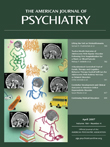Acute Chorea and Hyperthermia After Concurrent Use of Modafinil and Tranylcypromine
To the Editor: The combination of monoamine oxidase inhibitors (MAOIs) and sympathomimetic psychostimulants can produce hypertensive crisis and serotonin syndrome. To our knowledge, similar reactions have never been described with modafinil and MAOIs, presumably because modafinil lacks sympathomimetic effects of amphetamine and methylphenidate. We report a case of a patient with acute chorea, confusion, and hyperthermia that developed after concurrent use of modafinil and tranylcypromine.
A 34-year-old Caucasian female was admitted to our facility because of chorea and confusion. She had a 15-year history of refractory depression, which had been stable on high-dose tranylcypromine (80 mg daily). Three days prior to admission, she began taking modafinil 200 mg daily to improve wakefulness in the setting of increased workload. She had not taken modafinil on a regular basis before this.
On the morning of admission, her parents noted that she appeared restless. Seven hours later, she was sent to the emergency room by her coworkers because she was behaving “strange[ly]” and had "tics." At presentation, her verbal responses were in single words and inappropriate. Severe choreiform movements of all four limbs, lip smacking, and rhythmic rapid tongue protrusions were observed. Her neck was in opisthotonus with rhythmic bilateral rotations.
The patient was admitted to our intensive care unit. Tranylcypromine and modafinil were discontinued. A head CT scan, CSF analysis, EEG, laboratory tests, and toxicology screens were unrevealing. The patient was started on a regiment of cyproheptadine for presumed serotonin syndrome. Her temperature rose to 38° C 24 hours after presentation, remained elevated for 24 hours, and then normalized spontaneously. Other vital signs remained normal throughout her stay. The patient’s symptoms resolved within 48 hours of admission.
A recent case report of modafinil combined with tranylcypromine suggests that such treatment is safe (1) . In our patient, symptoms developed three days after modafinil was added to tranylcypromine and resolved two days after discontinuation of both. Since other etiologies of self-limited chorea were excluded, we presume the symptoms were precipitated by concurrent use of modafinil and tranylcypromine.
Orofacial and limb dyskinesias have been reported with modafinil (2) . Some studies indicate that modafinil has a central dopaminergic effect (3) , which could explain the occurrence of dyskinesias. Other studies demonstrate that modafinil increases cortical serotonin levels by enhancing the efficacy of serotonin release mechanism (4) . We hypothesize that tranylcypromine produced acute dyskinesias, confusion, and hyperthermia in our patient by augmenting central dopaminergic and serotoninergic activity of modafinil. We feel that hyperthermia and confusion represent an incomplete form of serotonin syndrome.
This case illustrates the need for a study on safety of combining modafinil with MAOIs.
1. Clemons WE, Makela E, Young J: Concomitant use of modafinil and tranylcypromine in patient with narcolepsy: a case report. Sleep Med 2004; 5:509–511Google Scholar
2. Luborzewski A, Regen F, Schindler F, Angelescu I: Modafinil-induced reversible hyperkinetic nondystonic movement disorder in patient with major depressive disorder. J Neuropsychiatry Clin Neurosci 2006; 18:248–249Google Scholar
3. Wisor JP, Nishino S, Sora I, Uhl GH, Mignot E, Edgar DM: Dopaminergic role in stimulant-induced wakefulness. J Neurosci 2001; 21:1787–1794Google Scholar
4. Ferraro L, Fuxe K, Tanganelli S, Fernandez M, Rambert FA, Antonelli T: Amplification of cortical serotonin release: further neurochemical action of vigilance-promoting drug modafinil. Neuropharmacology 2000; 39:1974–1983Google Scholar



